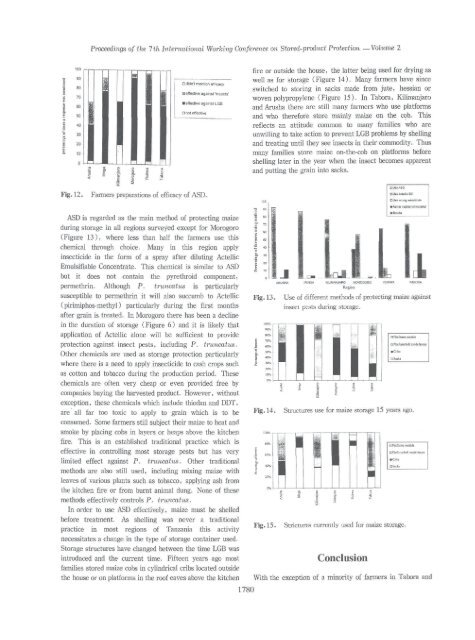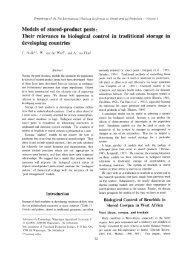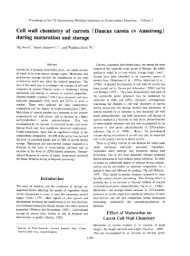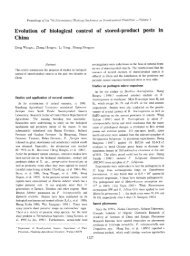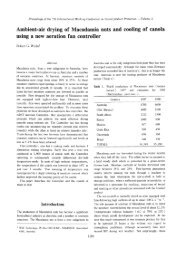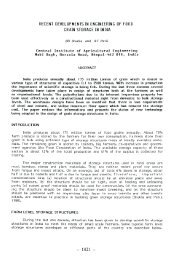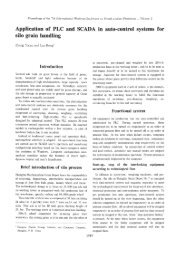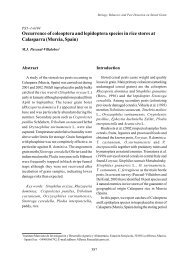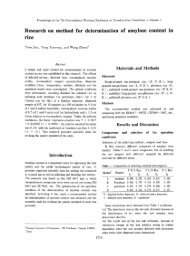Coping strategies employed by farmers against the larger grain ...
Coping strategies employed by farmers against the larger grain ...
Coping strategies employed by farmers against the larger grain ...
You also want an ePaper? Increase the reach of your titles
YUMPU automatically turns print PDFs into web optimized ePapers that Google loves.
100<br />
'0<br />
80<br />
70<br />
60<br />
50<br />
40<br />
30<br />
20<br />
10<br />
Proceedi'l1{lsof <strong>the</strong> 7 til Interrwtianat Working Conference on Stored-prodvct Protectian - Vot1tme 2<br />
.<br />
"<br />
n-<br />
Odinn" menton efficacy<br />
[i) effective <strong>against</strong><br />
L<br />
'insects'<br />
' O'Ife'Ii" aqains<br />
OnoteffectlVe<br />
LGB<br />
Fig. 12. Farmers preparations of efficacyof ASD.<br />
ASD is regarded as <strong>the</strong> main method of protecting maize<br />
during storage in all regions surveyed except for Morogoro<br />
(Figure 13), where less than half <strong>the</strong> <strong>farmers</strong> use this<br />
chemical through choice. Many in this region apply<br />
insecticide in <strong>the</strong> form of a spray after diluting Actellic<br />
Emulsifiable Concentrate. This chemical is similar to ASD<br />
but it does not contain <strong>the</strong> pyrethroid component,<br />
permethrin. AIthough P. tnmcatvs is particularly<br />
susceptible to permethrin it will also succumb to Actellic<br />
(pinmiphoe-methyl ) particularly during <strong>the</strong> first months<br />
after <strong>grain</strong> is treated. In Morogoro <strong>the</strong>re has been a decline<br />
in <strong>the</strong> duration of storage (Figure 6) and it is likely that<br />
application of Actellic alone will be sufficient to provide<br />
protection <strong>against</strong> insect pests, including P. truncatus .<br />
O<strong>the</strong>r chemicals are used as storage protection particularly<br />
where <strong>the</strong>re is a need to apply insecticide to cash crops such<br />
as cotton and tobacco during <strong>the</strong> production period. These<br />
chemicals are often very cheap or even provided free <strong>by</strong><br />
companies buying <strong>the</strong> harvested product. However, without<br />
exception, <strong>the</strong>se chemicals which include thiodan and DDT,<br />
are' all far too toxic to apply to <strong>grain</strong> which is to be<br />
consumed. Some <strong>farmers</strong> still subject <strong>the</strong>ir maize to heat and<br />
smoke <strong>by</strong> placing cobs in layers or heaps above <strong>the</strong> kitchen<br />
fire. This is an established traditional practice which is<br />
effective in controlling most storage pests but has very<br />
limited effect <strong>against</strong> P. iruncatus . O<strong>the</strong>r traditional<br />
methods are also still used, including mixing maize with<br />
leaves of various plants such as tobacco, applying ash from<br />
<strong>the</strong> kitchen fire or from burnt animal dung. None of <strong>the</strong>se<br />
methods effectively controls P. truncatu«.<br />
In order to use ASD effectively, maize must be shelled<br />
before treatment. As shelling was never a traditional<br />
practice in most regions of Tanzania this activity<br />
necessitates a change in <strong>the</strong> type of storage container used.<br />
Storage structures have changed between <strong>the</strong> time LGB was<br />
introduced and <strong>the</strong> current time. Fifteen years ago most<br />
families stored maize cobs in cylindrical cribs located outside<br />
<strong>the</strong> house or on platforms in <strong>the</strong> roof eaves above <strong>the</strong> kitchen<br />
fire or outside <strong>the</strong> house, <strong>the</strong> latter being used for drying as<br />
well as for storage (Figure 14). Many <strong>farmers</strong> have since<br />
switched to storing in sacks made from jute, hessian or<br />
woven polypropylene (Figure 15). In Tabora , Kilirnanjaro<br />
and Arusha <strong>the</strong>re are still many <strong>farmers</strong> who use platforms<br />
and who <strong>the</strong>refore store mainly maize on <strong>the</strong> cob. This<br />
reflects an attitude common to many families who are<br />
unwilling to take action to prevent LGB problems <strong>by</strong> shelling<br />
and treating until <strong>the</strong>y see insects in <strong>the</strong>ir commodity. Thus<br />
many families store maize on-<strong>the</strong>-cob on platforms before<br />
shelling later in <strong>the</strong> year when <strong>the</strong> insect becomes apparent<br />
and putting <strong>the</strong> <strong>grain</strong> into sacks.<br />
90 ~<br />
~ BU<br />
s~<br />
'j; ,~ so<br />
"o<br />
~ 30<br />
20<br />
t:. 10<br />
" E<br />
KlllMANJI\RO MOROGORO<br />
Region<br />
oUseASD<br />
oUseAclellicEC<br />
.Adm;': tradllionol maleri<br />
t j ~<br />
OPIOlfollnSOUl.Side<br />
OPla,roTl1lllollinsi


